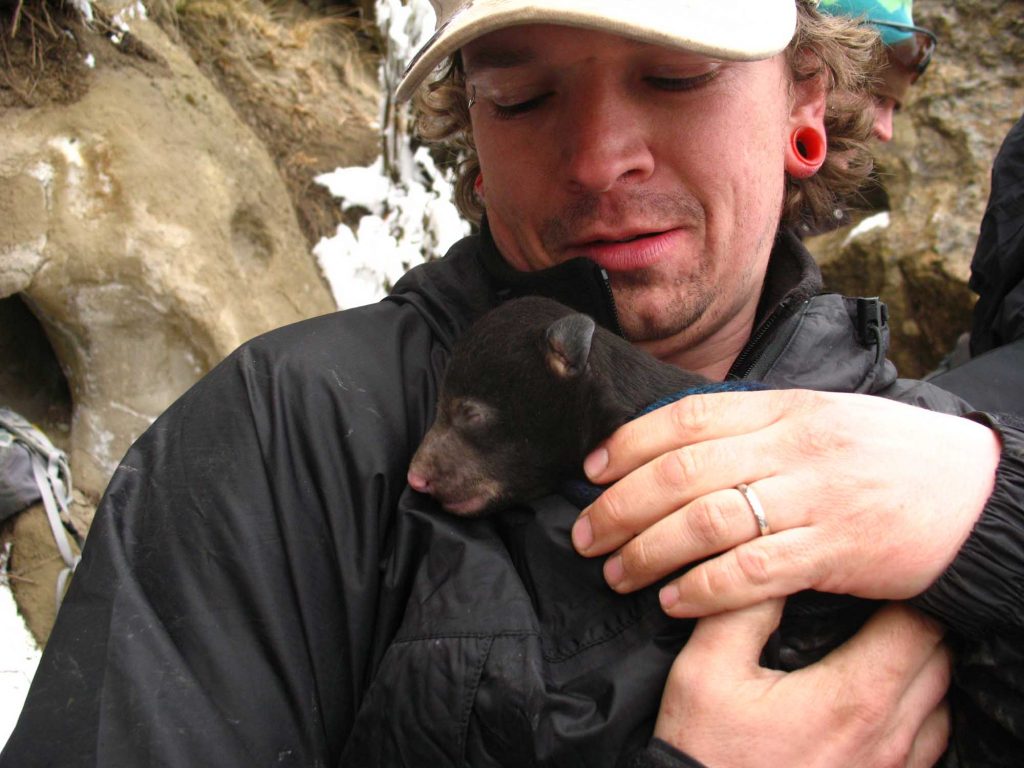The “Bear” necessities
Food, shelter and protection; those are the “bear” necessities – at least for bear cubs, anyway. A sow sacrifices a lot to ensure the viability of her offspring. However, despite that, biologists find it necessary to track down some female bears to determine their health and observe whether or not they were able to give birth. If so, the biologists check the number of young and their health as well.

This archived article was written by: James Bailey
Food, shelter and protection; those are the “bear” necessities – at least for bear cubs, anyway. A sow sacrifices a lot to ensure the viability of her offspring. However, despite that, biologists find it necessary to track down some female bears to determine their health and observe whether or not they were able to give birth. If so, the biologists check the number of young and their health as well.
The data collected aids in specifying the population dynamics of the bears, and to decide whether to allow hunting, and if so, how many hunting permits to issue, and so forth. It also assists the biologists in predicting bear and human conflicts and possibly how any situation might be dealt with.
For wildlife biologist, Brad Crompton, of the Division of Wildlife Resources, this is part of his every day job. On March 9, students and professors from USU Eastern and Utah State University in the Uintah Basin were able to take part in the opportunity to join Crompton and have real “hands-on” experience.
Students from USU Eastern had the opportunity to participate in this research because of the on-campus wildlife club. Associate Professor Mike King is the club advisor and Josiah Safely serves as the student president. This wildlife club was the vehicle by which the bear denning was organized.
The bear denning took place in Nash Wash – near the Colorado/Utah border in the general vicinity of Cisco, Utah and Grand Junction, Colo.
The dirt roads were extremely muddy and made passage difficult. The group traveled by vehicle to the Nash Canyon Rock House and then everyone continued the journey afoot. Furthermore, nearly knee deep snow and a thousand-plus-foot elevation change made the hike to the den a brutal one, despite it being only a couple miles round-trip. What awaited the group, however, was well worth the climb.
Using a radio telemetry receiver, Crompton picked up the signal emitted by a radio collar that had been previously affixed to the sow bear. This aided in locating the den. A general location had already been provided by a fly-over with a chopper a few days earlier. That narrowed the search, however, down to a branch canyon. Lots of footwork was the only way to find the actual den where the bear was hibernating.
Once the den’s location was established, Crompton climbed into the den head-first and sedated the mother by tranquilizing it with a dart pistol.
According to Crompton, contrary to popular belief, bears do not hibernate – they enter a state of torpor, which is not nearly as deep as hibernation and therefore this necessitates that the mother be sedated not only for the safety of the people, but also to ensure the mother is not too traumatized – which could cause the mother to abandon her young.
Once the animal was safely sedated, the cubs were removed from the den for a period of time so a new radio collar could be placed around the mother’s neck. Much to the awe and enjoyment of the students and university staff, the cubs were passed around the group for a unique experience of holding and cuddling them. To keep the cubs warm, everyone held each cub inside his or her coat.
Once Crompton was done with the new radio collar, some also took advantage of the opportunity to climb into the den and get up close and personal with the mother.
Some students worried that by holding the cubs, they would inadvertently pass their human smell onto them. That might cause their mother to not recognize her cubs and therefore abandon them. However, Crompton stated that it is extremely rare for a mother to do so after the cubs have been handled by humans.
It was good to see that the sow had reproductive success. Crompton told the group at the beginning of the hike that this was one of four orphaned bears transplanted in Nash Wash. This remaining bear was the only living of those four. Of the three that died, one was killed and eaten by a mountain lion, another died of natural causes, and the third, unfortunately had to be put down by Crompton because it had become a nuisance bear and was a danger. To see at least one of the four orphaned bears able to have offspring was pleasing.
After all the data was collected, a motion-activated trail cam was placed near the den to capture photos of the cubs as they emerge in the next couple of weeks to pack on the weight they need to grow and survive.
Another misguided belief is that bears eat mostly meat. The students were instructed that the bear’s diets, after leaving the den, will be made up of mostly grass and other plants. Black bears may occasionally consume carrion and even more rarely actually hunt. Though bears are omnivores, their diet is mostly vegetation.
After perhaps an hour at the den, the students and instructors began the descent back toward the vehicles and eventually home. This was an experience these students will likely never forget, and the hands-on experience was a chance to learn a great deal outside the walls of the classroom.
For more information regarding USU Eastern’s Wildlife program contact King, at 435-613-5400.




